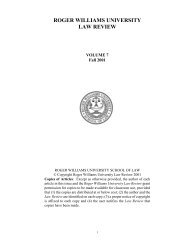AMICUS Vol. 2, No. 1 (Spring 2003) - Roger Williams University ...
AMICUS Vol. 2, No. 1 (Spring 2003) - Roger Williams University ...
AMICUS Vol. 2, No. 1 (Spring 2003) - Roger Williams University ...
Create successful ePaper yourself
Turn your PDF publications into a flip-book with our unique Google optimized e-Paper software.
Loan Repayment<br />
Assistance Programs<br />
National and Local Efforts<br />
by Carly Beauvais Iafrate, ‘ 00<br />
Many law school graduates must pay a significant student loan debt.<br />
The American Bar Association Commission on Loan Repayment<br />
and Forgiveness has found that excessive law school student loan<br />
debt prohibits many attorneys from considering public sector<br />
employment because of the traditionally lower salaries associated<br />
with these positions. To address the problem, there is currently a<br />
national movement toward establishing Loan Repayment Assistance<br />
Programs (LRAPs). Generally, LRAP applicants may be entitled<br />
to have a portion of their student loan debt forgiven in exchange<br />
for public service. Although LRAPs directly benefit only those who<br />
qualify, all attorneys should be interested in promoting LRAPs<br />
to raise awareness of the problem. Eventually, we might establish<br />
preventative rather than remedial measures to address the high<br />
cost of law school.<br />
Rhode Island<br />
The local effort toward creating a LRAP<br />
was initiated by Chief Justice Frank J.<br />
<strong>Williams</strong> in 2001. The Chief Justice’s<br />
proposal was to create a state-funded<br />
program for attorneys in any public service,<br />
similar to loan forgiveness programs<br />
available to other professions. Several<br />
surveys were conducted to confirm that<br />
such a program was needed. The initial<br />
survey revealed that 66% of those full-time<br />
state attorneys making between $30,000<br />
and $50,000 per year had student loan<br />
debt between $50,000 and $100,000+.<br />
Of those who responded to the second<br />
survey, the average student loan debt<br />
was $65,000. Many department heads<br />
responded that they would have entered<br />
state service earlier if such a program<br />
was available, or that they had lost wellqualified<br />
attorneys to private sector<br />
employment because of the difficulty<br />
of paying their student loan debt on a<br />
public sector salary.<br />
The draft legislation entitles all full-time<br />
state employees licensed to practice law in<br />
Rhode Island to apply. Under the statute,<br />
the Rhode Island Student Loan Authority<br />
is vested with the power to promulgate<br />
specific regulations to implement the<br />
LRAP, including additional eligibility<br />
criteria. The statute itself makes clear that<br />
a state attorney is only eligible if he or<br />
she signs a contract agreeing to remain in<br />
public service for one year for each year<br />
that he or she receives financial assistance<br />
from the LRAP. If the attorney does not<br />
satisfy his or her service requirement then<br />
the assistance becomes a loan and must<br />
be repaid. The assistance can be applied<br />
to any educational debt, and therefore, is<br />
not limited to law school loans. The most<br />
critical factor to determining the amount<br />
of assistance is the applicant’s income-todebt<br />
ratio. The maximum amount of<br />
assistance per year is $10,000.<br />
Nationwide<br />
Currently, seven statewide LRAPs are in<br />
existence. The following is a brief description<br />
of each program.<br />
Arizona<br />
Created in 1990, the Arizona LRAP is<br />
designed to assist attorneys working fulltime<br />
for non-profit legal organizations.<br />
To be eligible, the applicant can make no<br />
more than $45,000 per year, with some<br />
exceptions, and must be a member of the<br />
state bar. If eligible, the foundation will<br />
“loan” the applicant up to $6,000 per year<br />
(however, in 2002 the total amount to<br />
be allocated was only $28,000). For more<br />
specific information, contact the Arizona<br />
Foundation for Legal Services and<br />
Education, 111 W. Monroe, 18 th Floor,<br />
Phoenix, AZ 85003, (603) 340-7356,<br />
http://www.azbf.org/AZFLSE/<br />
legalservices/loanrepayment.cfm.<br />
Florida<br />
Florida created a LRAP in 1991, which<br />
was terminated in 1995, but has been<br />
recently reestablished. Its program is for<br />
attorneys working full-time for civil legal<br />
aid only. The income cap is $40,000 per<br />
year, with an additional $3,000 per year<br />
increment. The LRAP applies only to law<br />
school loans and a participant may only<br />
receive aid for five consecutive years. The<br />
program is administered by the Florida<br />
Bar Foundation, 109 East Church Street,<br />
Orlando, FL 32801, (407) 843-0045,<br />
www.flabarfndn.org.<br />
Maryland<br />
Maryland has the oldest LRAP, created in<br />
1988. The Maryland LRAP is funded by<br />
the state, and is open to a broad range of<br />
public servants, including state and local<br />
AT ISSUE…<br />
7

















